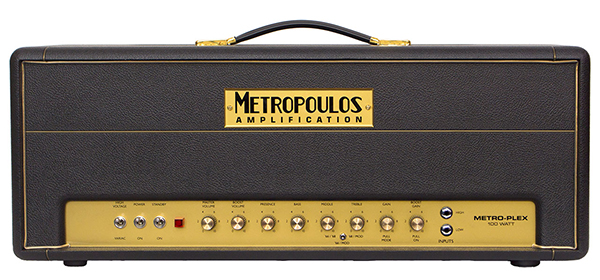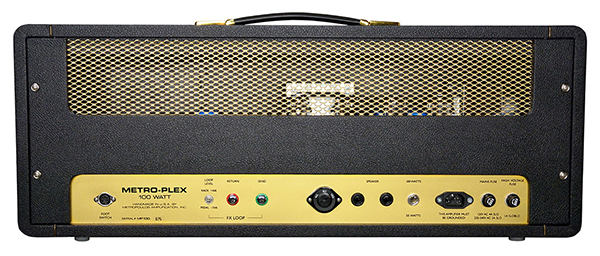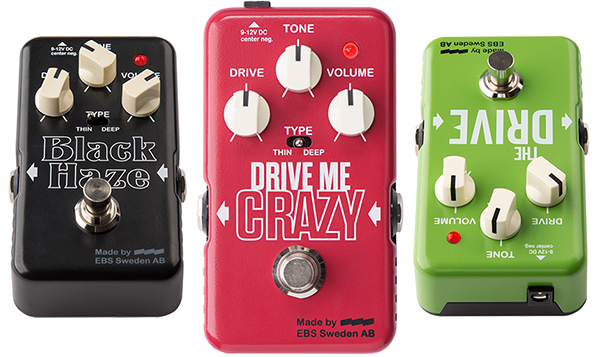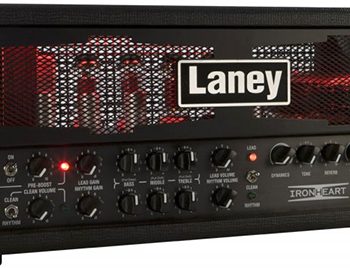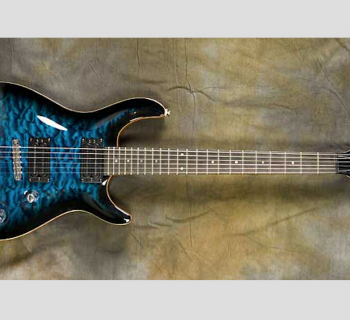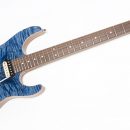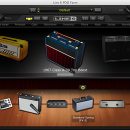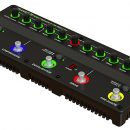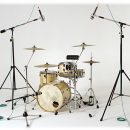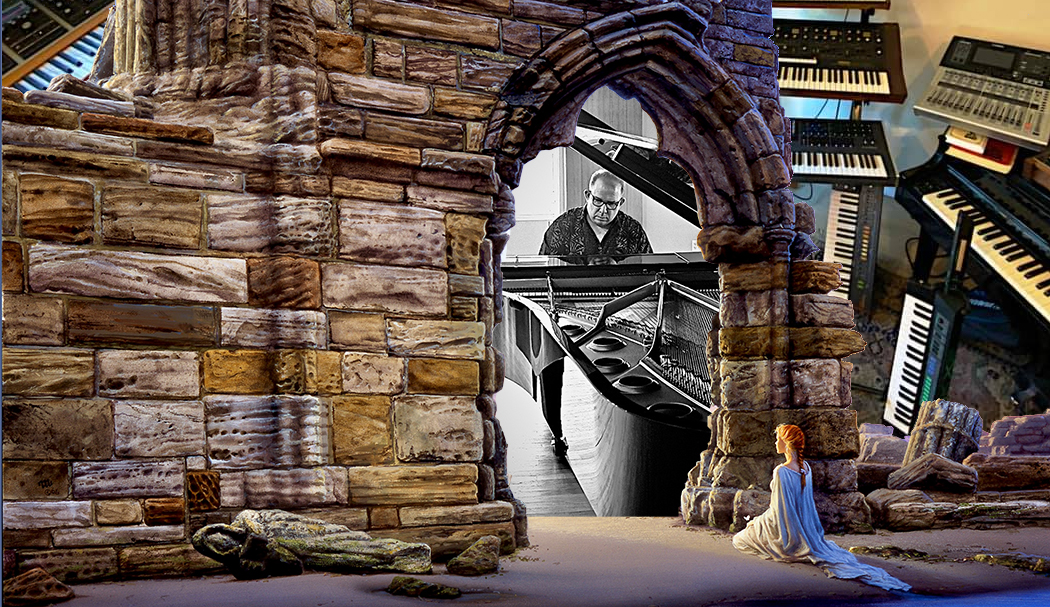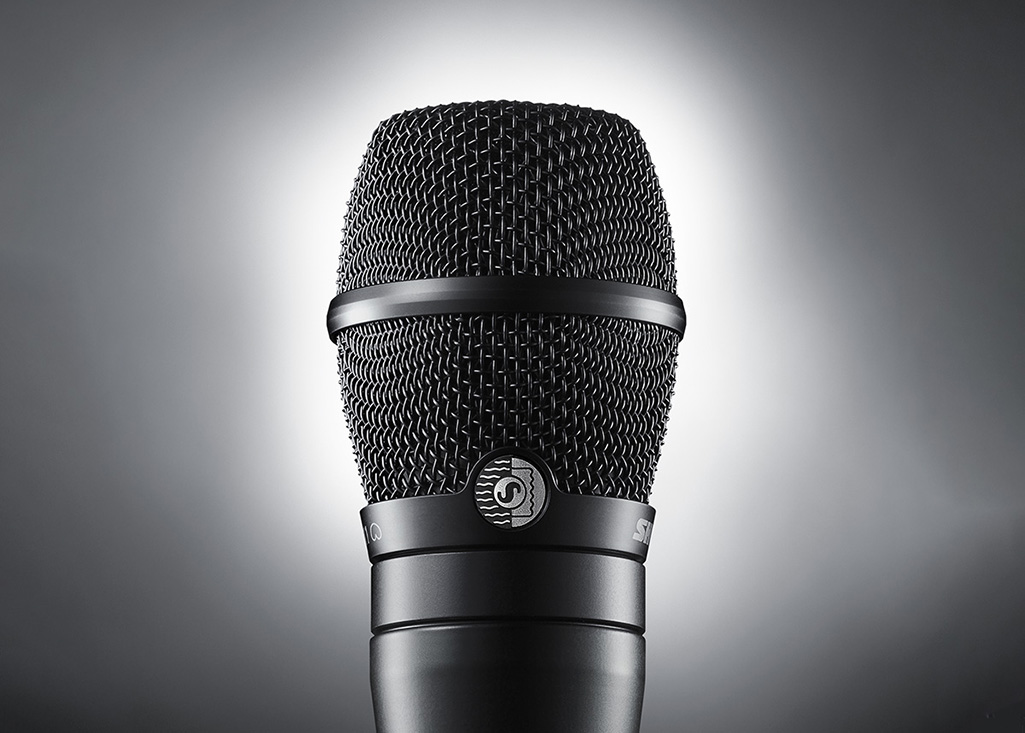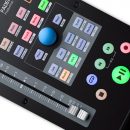When discussing legendary 100-Watt guitar amplifier heads, the Marshall Plexi is often cited as a definitive, end-all tone that is a "must have" in any serious musician's stable. The 1959 model Plexi (the Super Lead) was in production from the mid 1960s until 1981, when it was replaced by the JCM line. Tone chasers have two routes to choose from in their quest for the holy grail: find an original, four- or five-decades-old amp or scour the marketplace for a good clone. A vintage Plexi will come with its own host of reliability issues, though, not to mention being limited by abysmal 1960s technology—no effects loop, no channel switching, etc. A clone or a re-issue can also be hit or miss in terms of authenticity, build quality, and functionality. Obviously, finding an amp that can nail the classic Plexi sound but incorporate it into something a bit more versatile would be ideal.
George Metropoulos just may be the biggest Plexi enthusiast we know, with more than a few desert island Plexis in his personal collection. Metropoulos Amplification began life as a builder of Plexi clones with a few modern appointments (check out some YouTube videos with side-by-side demos of George's older Plexi clones). Recently, Metropoulos introduced their flagship amp: the Metro-Plex. This fantastic tone machine is a two-channel, 100w, multiple-voiced, fire breather, with a versatile tonal palate that can take you from classic Plexi rock tones to edgy '80s rock and beyond.
Features
The Metropoulos Metro-Plex was designed based on the tone of a 1968 Marshall Super Lead played through a 1968 basket-weave slant cab loaded with G12M speakers. The aesthetic of the amp is undeniably classic, with its black Tolex and gold faceplate. This is not an amp you order in diamond grill, snakeskin, or with flames painted on it. We feel it's the intent of the design to have classic appeal, and the head has that in spades.
But that's just where things get started, and clearly, a lot of thought and real-world R&D went into creating the Metro-Plex. It's almost as if Metropoulos knew he was sending us one for review and had to make sure the amp was loaded with everything we love. This very well laid out 100w head includes four Tung-Sol EL34 power tubes and two Mullard CV4004 preamp tubes. The controls begin with three toggles in the leftmost section of the faceplate. The typical on/off and standby toggle are joined by a Variac/high-voltage toggle. How cool! You can simulate variac'ing a Plexi down to 100V wall voltage with a simple flip of a switch on the face of the amp! (Technically, the plate voltage swings from around 480V in normal operation to around 410V in variac operation.)

Master and Boost volume comes next. Master volume sets the overall volume of where you want the amp's channel, while the Boost volume adds an FET-type boost to your sound for that searing lead work. Standard Presence, Bass, Middle and Treble knobs follow, along with separate Gain and Boost controls. A three-way toggle sits underneath the Middle and Treble knob, allowing for channel switching without a footswitch.
This amp channel switches in an interesting and somewhat unique way, delivering three different modes of amp configuration based on your selections. You can start with the standard choice between '66 and '68 Plexi channels or you have options for a standard '66 with a modded '66 or a standard '68 with a modded '68. This offers great flexibility in tones depending on your use. (This toggle is defeated when the footswitch is engaged.)
 The Gain and Boost controls each have push/pull functions. The Gain knob selects the amp channel, or Mode, as Metropoulos calls it. The Boost control when pulled activates the boost circuit, making control of the gain and boost level active. Both of these features are also defeated by a three-button footswitch (which can also hard bypass the effects loop).
The Gain and Boost controls each have push/pull functions. The Gain knob selects the amp channel, or Mode, as Metropoulos calls it. The Boost control when pulled activates the boost circuit, making control of the gain and boost level active. Both of these features are also defeated by a three-button footswitch (which can also hard bypass the effects loop).
The footswitch uses a familiar MIDI five-pin DIN connection. Although the amp is not MIDI-aware, the DIN-5 cable format is commonly used. However, we'd have really prefered to see the cable not hardwired at one end to the footswitch. If our cable shorts out, gets run over, or otherwise dies, it's not user serviceable.
High and low ¼" input jacks round out the face of the amp and have a lot to do with the responsiveness of the sound. More on this later.
The back of the amp includes a loop level toggle for the series-wired effects loop and impedance controls for the pair of speaker jacks. We were thrilled to see a half-power switch back here, allowing for 50w operation. Standard IEM power and our 2 fuses complete the package.
Usability
We've tested many 100w heads over the years, and this one had a few features in it worth getting to know. Access to those features were well thought out—as well as footswitchable. We paired our Metropoulos Metro-Plex with a Mezzabarba 4x12 cab loaded with 25w Greenbacks. It was simple enough to set the amp to 16 ohms, connect the footswitch and speaker cabinet, select the proper level for the loop, select the 50w or 100w option, and then not have to look at the back of the amp again. There is no conceivable need to ever change impedance or loop level during a gig, unless it was pilot error to begin with. All the features we would want access regularly were on the face of the amp.
Toggling between the modes of the amp as well as applying the boost were simple enough using the supplied footswitch. Dialing in tones couldn't have been easier on the face of the amp. Functionally, it's as simple as classic Marshall heads with a few bonus options thrown in.
We feel the separate boost volume (and not a separate channel volume) was a great design choice. It allows flexibility for volume-boosted solos with user defined amounts of additional gain across two channels. Many amps have a rhythm and a lead channel. Here, we have two rhythm channels, which can be used as lead channels whenever we'd like thanks to this design. The possibilities are endless with this configuration.
Want a laid-back lead/melody line in a song as well as a lead? Set the boost volume above the channel, and pull back on the boost gain and you're there. One channel is always a bit more aggressive than the other, so the boost will enhance things accordingly. We quickly learned that the Metro-Plex delivers a great, old school sound with modern features all in one amp. It was like driving a '70s Barracuda with GPS navigation and heated seats.
Tip: Not all effects loops are wired Send/Return. Some, based on circuit layout, end up Return/Send. Don't make the mistake we did and not look at what you're doing when connecting your cables!
Sound
We began testing with a Knaggs Kenai guitar—a boutique, dual humbucker, solid-body guitar which has sounded great when paired with many EL-34-based amps in our collection. We set our presence to a little past 5, Bass at 6, Middle at 7, and Treble at 7. Gain was nearly dimed out and we selected the 66/Mod position on the channel voicing. The amp was set to 100w and the Variac was set to High voltage.
We loved the amp at this setting right out of the box. We have played many Marshall amps in the past and found this amp to be voiced much like their classic incarnations. Bass, Middle and Treble also responded accordingly. Power chords had that slamming impact and articulation heard on so many recordings.
The saturation in our best, bar-rock power chord imitations was definitely just what the doctor ordered. Hitting the Variac switch yielded a spongier, slower response and made the overdrive a little fuzzier in this setting. Selecting the Mod switch on the footswitch gave us more gain, better saturation, and a small bump in volume. We felt this mode setting—the 66/Mod mode—would be best suited to playing '60s-era rock with a good amount of clean parts in the material but still needed some great overdrive for lead work.
Rolling back the guitar's volume cleaned up the sound nicely, but also consider that we could have set up the amp with lower gain settings and used the boost for leads, too.
Switching the amp to the 68/Mod mode, this was our favorite mode of this amp. The 68 voice, in and of itself, is literally the holy grail of British amp tone. Recordings that will outlive humanity were recorded with just this sound. Switching to the Mod voicing of this mode gave us an early Van Halen-type of tone, which was glorious. There was a good amount of natural amp compression and enough saturation to satisfy period correct, early '80s rock leads. Reasonably setting the boost on this mode got us a bit more modern tone, but this wasn't ever a modern sounding high gain head. This voicing delivers a great sound and is extremely versatile, but the levels of gain stop somewhere around the mid '80s sound. Players who desire more gain than that will want to add an appropriate overdrive or distortion pedal to the front end. We particularly loved the Boss DA-2 Adaptive Distortion pedal on this channel with the gain throttled back a little. Our four-knob Keeley Compressor also provided useful results.
Our next sound test was at a bar gig (where amps like this really shine, playing the best of AC/DC and the like) with about 100 friends and bar crawlers ready to rock out. We mated the Metropoulos to a Friedman 4x12 cab, which contained a mix of V30s and Greenbacks. Given the completely different room and cab, we stepped off stage right before going on and fell in love with the guitar sound at the back of the room (wireless, of course). We peppered to taste, bringing treble and presence a bit more under control, and it was simply perfect. We were also sound testing the BAE Hot Fuzz Pedal that evening, and it was perfectly mated, and a period correct sound as well. We had a lot of fun with this one!
Our last sound test admittedly came right before publishing, but we had to get this one in, too. We received an ingenious Metropoulos 2x12 slant, closed-back cab with 75-Watt Creambacks, and were told the amp was voiced for just these speakers. We couldn't in good faith publish a review and not give our opinion on this amp without hearing it the way it was designed to be heard. The cab was also just as attractive as the head it was built for, and this pairing was definitely worth the wait.
We set up at a medium sized club in northern New Jersey for a two-set night, and the tone was so great we barely missed our 4x12 setup. Loading this cabinet with 2-G12H75 Creamback Clestions was a good choice, indeed! The sound for the night cut through perfectly, and reflected well in the room. We must say, though… be sure you want this kind of sound. It delivers that Led Zepplin, Hendrix, and early Van Halen sound beautifully, which took some getting used to with our band, which was more accustomed to hearing us play with more modern, high-gain tones. The amp takes really well to pedals, so having various drive options on the pedalboard in front of the input worked extremely well.
We placed two of our beloved effects units in the effects loop: the TC Electronic G-System and Eventide H9. Our H9's deep reverbs sounded impressively lush through this amp, while the G-System delivered classic golden ratio chorus and other time-based effects. This is a remarkably transparent loop, and we have word that its design has even been licensed by other high-end, boutique amp manufacturers.
Video courtesy of Metropoulos and Destroy All Guitars |
Documentation and Product Support
A very detailed suggested sound booklet is included with the Metro-Plex which gave us dozens of suggested settings, however there is no actual product user's manual. There are many detailed videos on Metropoulous's YouTube page, but more novice players or players taking their first stab at a boutique amp might would benefit from more detailed explanation of some of the settings and features.
Metropoulos were very good at answering emails, as well as providing phone support, and the website provides plenty of useful information.
Price
The Metropoulos Metro-Plex sells for $3,550. Boutique gear often struggles in the Price category, but considering you are really getting the tone of the amps that Metropoulos pays homage to, which cost twice as much on the used market and are decades old, the Metropoulos Metro-Plex is a worthy consideration. For the tone purist seeking vintage Marshall tone in a modern amplifier, this belongs on your short list.
| Contact Information Metropoulos Amplification www.metropoulos.net |

